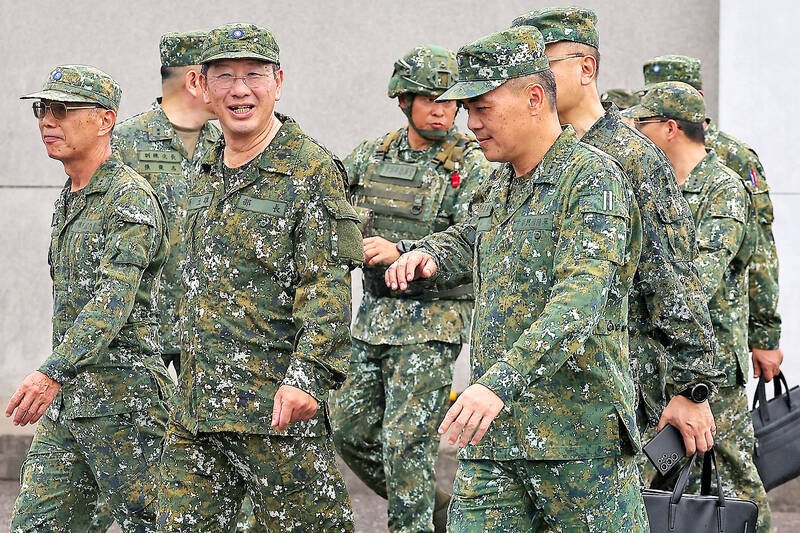Taiwan intends to focus on the research, development and implementation of drone systems, artificial intelligence (AI) and other advanced technologies to fortify the nation’s defense, Minister of National Defense Wellington Koo (顧立雄) said at a meeting with journalists on Wednesday.
As part of this initiative, Taiwan has established the Defense Innovation Team — its own version of the US’ Defense Innovation Unit — which will focus on drone development, counterdrone systems and defense applications of AI, Koo said in comments embargoed until yesterday.
This was in line with a pledge Koo made earlier this year that he would oversee a new team that would bring together the nation’s military and private companies to boost the nation’s asymmetrical warfare capabilities.

Photo: Ann Wang, Reuters
During the meeting, Koo spoke about how this year’s national defense budget reflects the importance of asymmetric warfare and the need to invest in Taiwan’s reserves.
However, traditional military hardware is still necessary to defend against China’s “gray zone” tactics, he added.
The Defense Innovation Team would evaluate submissions from the military branches and lead a cross-ministerial process that includes the National Science and Technology Council, the Ministry of Economic Affairs and the Ministry of Digital Affairs, he said.
If Taiwan lacks the necessary capabilities to implement proposals, the team would seek foreign support, having already had in-depth exchanges with its US counterpart, Koo said.
With the trend of decoupling from China, there is potential for Taiwan to produce or share production of much of the technology, he said.
Representatives from the US Department of Commerce are to visit Taiwan this month to discuss the possibility of joint production, he added.
Although the technology might not use Taiwanese branding for geopolitical reasons, Taiwan’s abilities in advanced technologies and its role in global supply chains can offer significant opportunities for dual-use goods such as drones, Koo said.
Friendly and unfriendly militaries will increasingly use drones, so the military branches would need to discuss how to effectively integrate new technologies and systems, not only in combat scenarios, but also in operational guidelines and training, Koo said.
The Army Education, Training and Doctrine Development Command has already ordered officers in charge of training to familiarize themselves with the new systems and adjust organizational structures as discussions continue and technology evolves.
China’s “gray zone” intrusions and large training exercises make it more difficult to identify when Taiwan is under threat, which means the nation’s forces might have less time to react than previously imagined, Koo said.
The minister, in rare comments about military cooperation, also said that Taiwan’s combat effectiveness has improved thanks to its deepening security partnership with the US and other friends and allies.
“In the past few years, Taiwan, the US and other friends and allies have continuously strengthened security partnerships, and continued to expand and deepen military cooperation,” he said. “This has contributed to the improvement of the national military’s combat effectiveness and regional peace and stability.”
Cooperation focuses on “substantively improving” combat effectiveness rather than just “formality,” Koo said.
“The defense ministry has never publicized this foreign military cooperation with great fanfare. This is due to taking into account the international situation and respect for our friends and allies. It is also to avoid unnecessary interference,” he added.
Koo also announced reforms to existing military training and equipment.
Close-quarters combat training would be fully implemented from next year onward, he said.
This comes after traditional bayonet drills were canceled this year following Koo’s appointment as defense minister.
Bayonet training is to remain outside of the new guidelines, he said.
The army, military police and reserves would start receiving new T112 rifles, with 86,114 units to be shipped between next year and 2028, Koo said.
Based on operational needs, the rifles are equipped with optical sights, tactical lights and lasers that help improve shooting speeds, reaction times and target acquisition, Koo said.
The Armaments Bureau is capable of meeting production targets, he said.
The bureau is also developing new ballistic plates that can withstand the Chinese military’s armor-piercing bullets, with production set to start next year.
Next year, the Armaments Bureau is to produce 25,000 T112 rifles, as well as 60,000 to 70,000 ballistic plates, bureau Deputy Director Huang Ching-pei (黃清培) said.
The bureau is also developing a new rifle which is due to be completed in March next year for testing by the military branches, Koo said.
Additional reporting by CNA and Reuters

FOUR DESIGNATED AREAS: Notices were issued for live-fire exercises in waters south and northwest of Penghu, northeast of Keelung and west of Kaohsiung, they said The military is planning three major annual exercises across the army, navy and air force this month, with the navy’s “Hai Chiang” (海強, “Sea Strong”) drills running from today through Friday, the Ministry of National Defense said yesterday. The Hai Chiang exercise, which is to take place in waters surrounding Taiwan, would feature P-3C Orion maritime patrol aircraft and S-70C anti-submarine helicopters, the ministry said, adding that the drills aim to bolster the nation’s offshore defensive capabilities. China has intensified military and psychological pressure against Taiwan, repeatedly sending warplanes and vessels into areas near the nation’s air defense identification zone and across

FORCED LABOR: A US court listed three Taiwanese and nine firms based in Taiwan in its indictment, with eight of the companies registered at the same address Nine companies registered in Taiwan, as well as three Taiwanese, on Tuesday were named by the US Department of the Treasury’s Office of Foreign Assets Control (OFAC) as Specially Designated Nationals (SDNs) as a result of a US federal court indictment. The indictment unsealed at the federal court in Brooklyn, New York, said that Chen Zhi (陳志), a dual Cambodian-British national, is being indicted for fraud conspiracy, money laundering and overseeing Prince Holding Group’s forced-labor scam camps in Cambodia. At its peak, the company allegedly made US$30 million per day, court documents showed. The US government has seized Chen’s noncustodial wallet, which contains

SUPPLY CHAIN: Taiwan’s advantages in the drone industry include rapid production capacity that is independent of Chinese-made parts, the economic ministry said The Executive Yuan yesterday approved plans to invest NT$44.2 billion (US$1.44 billion) into domestic production of uncrewed aerial vehicles over the next six years, bringing Taiwan’s output value to more than NT$40 billion by 2030 and making the nation Asia’s democratic hub for the drone supply chain. The proposed budget has NT$33.8 billion in new allocations and NT$10.43 billion in existing funds, the Ministry of Economic Affairs said. Under the new development program, the public sector would purchase nearly 100,000 drones, of which 50,898 would be for civil and government use, while 48,750 would be for national defense, it said. The Ministry of

SENATE RECOMMENDATION: The National Defense Authorization Act encourages the US secretary of defense to invite Taiwan’s navy to participate in the exercises in Hawaii The US Senate on Thursday last week passed the National Defense Authorization Act (NDAA) for Fiscal Year 2026, which strongly encourages the US secretary of defense to invite Taiwan’s naval forces to participate in the Rim of the Pacific (RIMPAC) exercise, as well as allocating military aid of US$1 billion for Taiwan. The bill, which authorizes appropriations for the military activities of the US Department of Defense, military construction and other purposes, passed with 77 votes in support and 20 against. While the NDAA authorizes about US$925 billion of defense spending, the Central News Agency yesterday reported that an aide of US